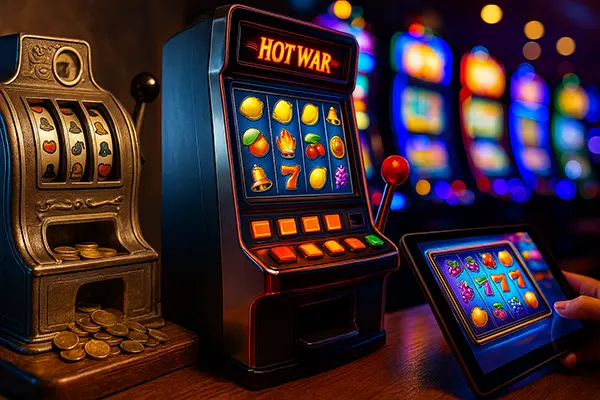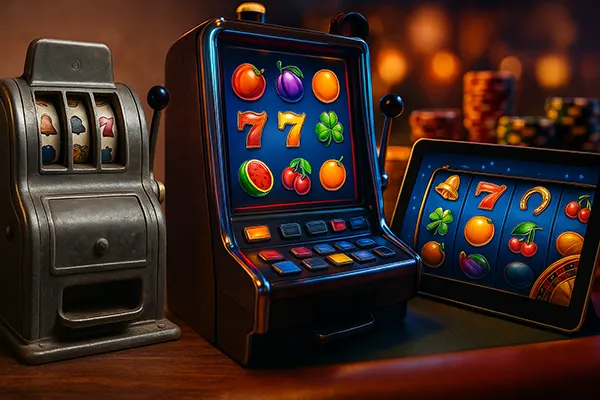
The History and Evolution of Slot Machines: From Mechanical Slots to Online Casinos
Slot machines have undergone a fascinating transformation from their early mechanical origins to the highly advanced digital versions found in online casinos today. Their journey is a testament to technological innovation, evolving player preferences, and the dynamic nature of the gambling industry. This article explores the key phases of slot machine evolution, highlighting significant milestones and developments.
The Birth of Mechanical Slot Machines
The story of slot machines began in the late 19th century with the invention of the first mechanical slot machine, the Liberty Bell, created by Charles Fey in 1895. The Liberty Bell featured three spinning reels and a single payline, and players could win prizes by matching symbols such as bells, horseshoes, and playing card suits. This machine laid the groundwork for all subsequent slot designs.
Mechanical slots grew in popularity throughout the early 20th century. As demand increased, new variations and designs emerged, often incorporating fruit symbols and simple mechanisms to ensure fair gameplay. These machines were entirely mechanical, relying on gears, levers, and springs to operate, making them susceptible to wear and tear.
Despite their rudimentary nature, mechanical slots became a staple in bars and casinos, captivating players with their simplicity and the thrill of pulling the lever. The sound of spinning reels and the iconic “ching” of a win made them immensely popular.
The Rise of Electromechanical Slots
The next major advancement came in the 1960s with the introduction of electromechanical slot machines. These machines incorporated electrical components while still retaining some mechanical elements. The most notable example was the ‘Money Honey’ by Bally, launched in 1964, which became the first fully electric slot with automatic payouts of up to 500 coins.
This innovation marked a turning point, as it allowed for more complex game features, including multiple paylines and the iconic “hopper” for storing coins. The use of electricity enabled more durable and reliable machines, significantly reducing maintenance issues compared to purely mechanical counterparts.
Electromechanical slots dominated the casino landscape for several decades, gradually replacing older mechanical models. They introduced new sounds and flashing lights, which added to the appeal and immersion for players.
The Digital Revolution: Video Slots
The 1970s and 1980s marked a revolutionary shift with the emergence of video slots. The first true video slot, developed by Fortune Coin Co. in 1976, used a modified Sony Trinitron television screen to display the game. Although met with initial skepticism, the concept quickly gained acceptance as casinos recognized the potential for increased payouts and engaging visuals.
Video slots eliminated the need for physical reels, allowing developers to experiment with more intricate game designs, bonus features, and thematic elements. As digital technology advanced, video slots became increasingly sophisticated, incorporating animated sequences, interactive bonuses, and diverse gameplay mechanics.
The popularity of video slots surged in the 1990s with the rise of computer-based gaming systems. Casino floors gradually transitioned to predominantly video-based machines, offering players a more visually stimulating and varied gaming experience.
The Birth of Progressive Jackpots
One of the most significant innovations in video slots was the introduction of progressive jackpots. These are linked networks of machines that accumulate a portion of each bet into a shared prize pool. The first major progressive slot, Megabucks by IGT, debuted in 1986, offering life-changing payouts to lucky winners.
Progressive jackpots revolutionized the appeal of slot machines, adding the allure of potentially massive wins. Players could win millions from a single spin, drawing huge crowds and cementing slots as the most popular casino game.
With each passing decade, progressive slot networks expanded, connecting machines across multiple casinos and even states, further increasing the potential jackpot amounts.

The Online Era: Digital and Mobile Slots
The advent of the internet in the late 20th century led to the birth of online casinos, forever transforming the gambling industry. Online slots became accessible from home, eliminating the need for physical casino visits. The first online slots were simple replicas of their land-based counterparts, but advancements soon brought original and innovative designs.
Modern online slots feature high-definition graphics, interactive themes, and diverse gameplay options. With mobile gaming, slots are now accessible on smartphones and tablets, allowing players to spin the reels from anywhere. HTML5 technology further enhanced performance, enabling seamless play on any device.
Online slots also introduced unique bonus rounds, customizable features, and branded content inspired by movies, TV shows, and celebrities. The convenience of online gaming combined with cutting-edge technology has made slots more popular than ever.
The Future of Slot Machines
The future of slot machines lies in the integration of artificial intelligence, augmented reality (AR), and virtual reality (VR). Developers are experimenting with immersive experiences that blur the line between gaming and reality, offering personalized gameplay and interactive storytelling.
Blockchain technology and cryptocurrencies are also shaping the evolution of online slots, providing transparent and decentralized gaming environments. As the gambling landscape continues to evolve, slot machines will undoubtedly remain at the forefront of innovation.
The enduring popularity of slots, driven by their ability to adapt and captivate, ensures that they will continue to evolve alongside technological advancements, offering players new ways to experience excitement and entertainment.



